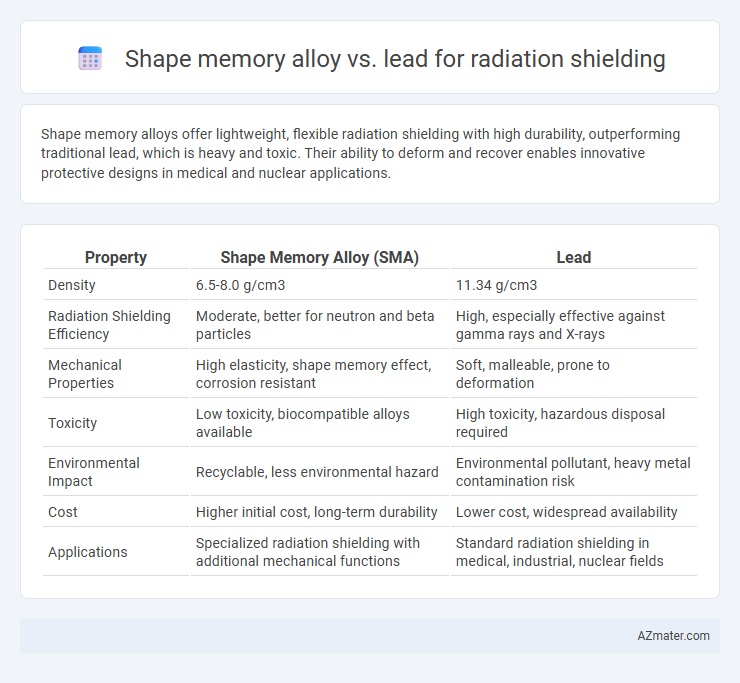Shape memory alloys offer lightweight, flexible radiation shielding with high durability, outperforming traditional lead, which is heavy and toxic. Their ability to deform and recover enables innovative protective designs in medical and nuclear applications.
Table of Comparison
| Property | Shape Memory Alloy (SMA) | Lead |
|---|---|---|
| Density | 6.5-8.0 g/cm3 | 11.34 g/cm3 |
| Radiation Shielding Efficiency | Moderate, better for neutron and beta particles | High, especially effective against gamma rays and X-rays |
| Mechanical Properties | High elasticity, shape memory effect, corrosion resistant | Soft, malleable, prone to deformation |
| Toxicity | Low toxicity, biocompatible alloys available | High toxicity, hazardous disposal required |
| Environmental Impact | Recyclable, less environmental hazard | Environmental pollutant, heavy metal contamination risk |
| Cost | Higher initial cost, long-term durability | Lower cost, widespread availability |
| Applications | Specialized radiation shielding with additional mechanical functions | Standard radiation shielding in medical, industrial, nuclear fields |
Introduction to Radiation Shielding Materials
Shape memory alloys (SMAs) and lead represent distinct categories of radiation shielding materials, each with unique properties influencing their effectiveness. Lead, a dense metal with high atomic number (Z=82), offers excellent attenuation of gamma rays and X-rays due to its density and electron density, making it a traditional choice for radiation protection. SMAs, composed mainly of nickel and titanium, provide structural advantages such as flexibility and recovery from deformation, though their lower density results in less effective gamma radiation attenuation compared to lead.
Overview of Shape Memory Alloys in Radiation Shielding
Shape memory alloys (SMAs) offer unique radiation shielding capabilities due to their ability to undergo reversible phase transformations, enabling adaptive protection in dynamic environments. Unlike lead, SMAs provide not only effective attenuation of ionizing radiation but also enhanced mechanical strength and corrosion resistance, making them suitable for aerospace and medical applications. Their lightweight characteristics combined with formability allow innovative design solutions where traditional heavy lead shielding is impractical.
Lead as a Traditional Radiation Shielding Material
Lead has been the traditional material for radiation shielding due to its high density of 11.34 g/cm3 and excellent attenuation of gamma and X-rays, effectively reducing radiation exposure in medical, industrial, and nuclear settings. Its malleability and relatively low cost make it easy to fabricate into various shielding forms such as sheets, bricks, and aprons. However, concerns about lead's toxicity and environmental impact have driven research into alternatives like shape memory alloys, which offer potential lightweight and safer radiation shielding solutions.
Physical Properties: Shape Memory Alloy vs Lead
Shape memory alloys (SMAs) exhibit higher tensile strength and superior corrosion resistance compared to lead, making them more durable in harsh radiation environments. Lead boasts a much higher density (11.34 g/cm3) than most SMAs, offering superior gamma radiation attenuation due to its atomic number and mass, critical for effective shielding. SMAs, typically composed of nickel-titanium, have variable elasticity and recoverable strain properties, contrasting with lead's malleable but permanently deformable nature.
Radiation Attenuation Efficiency Comparison
Shape memory alloys (SMAs) exhibit notable radiation attenuation efficiency due to their dense metallic composition and ability to undergo phase transformations that can influence neutron scattering. Lead remains a standard material for radiation shielding because of its high atomic number (Z=82) and density (11.34 g/cm3), providing superior gamma-ray attenuation through photoelectric effect and Compton scattering. Comparative studies reveal that while lead offers higher shielding effectiveness for gamma radiation, SMAs provide potential advantages in neutron radiation environments and structural adaptability, making them promising candidates in specialized radiation protection.
Weight and Density Differences
Shape memory alloys (SMAs) offer significantly lower density compared to lead, typically ranging between 6 to 7.5 g/cm3, whereas lead's density is approximately 11.34 g/cm3, making SMAs considerably lighter for radiation shielding applications. The reduced weight of SMAs enhances portability and structural integration in aerospace and medical shielding devices without compromising mechanical performance. However, lead's higher density provides superior attenuation properties per unit thickness, necessitating thicker or layered SMA designs to achieve comparable radiation protection.
Flexibility and Design Versatility
Shape memory alloys offer superior flexibility and design versatility compared to traditional lead in radiation shielding due to their ability to deform and return to predefined shapes, enabling customizable and adaptable protective solutions. Unlike lead, which is rigid and heavy, shape memory alloys facilitate complex geometries and tailored fits that enhance wearer comfort and mobility in medical and industrial environments. This adaptability supports innovative shielding designs that maintain effectiveness while reducing bulk and improving ergonomic benefits.
Toxicity and Environmental Impact
Shape memory alloys (SMAs) offer significantly lower toxicity compared to lead, which is highly toxic and poses severe environmental hazards due to its persistence and bioaccumulation. Lead contamination can lead to soil and water pollution, adversely affecting ecosystems and human health, whereas SMAs typically contain non-toxic metals like nickel and titanium, resulting in a reduced environmental footprint. The recyclability and durability of SMAs further minimize waste and environmental degradation, making them a safer and more sustainable option for radiation shielding applications.
Cost and Availability Considerations
Shape memory alloys (SMAs) generally present higher initial costs compared to lead due to complex manufacturing and alloy composition requirements, which limit their widespread availability. Lead remains more cost-effective and readily accessible, maintaining its status as a preferred material for radiation shielding in many industrial and medical applications. However, the increasing environmental and health regulations on lead disposal and usage may influence long-term availability and total cost of ownership in radiation protection solutions.
Future Trends in Radiation Shielding Technologies
Shape memory alloys (SMAs) offer promising advancements in radiation shielding due to their adaptability and self-healing properties, enabling dynamic protection in variable radiation environments. Unlike traditional lead shielding, which is heavy and toxic, SMAs can be engineered for lightweight, flexible, and eco-friendly radiation barriers, enhancing usability in aerospace and medical applications. Future trends emphasize integrating SMAs with nanocomposite materials and smart sensors to create intelligent shielding solutions that respond in real-time to radiation exposure.

Infographic: Shape memory alloy vs Lead for Radiation shielding
 azmater.com
azmater.com